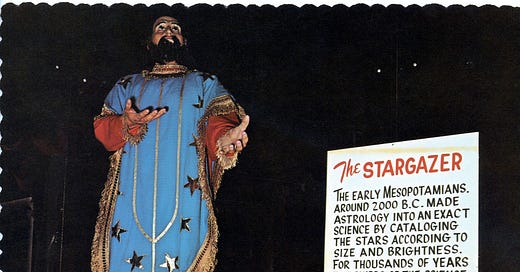Babylonian Priest-Astronomer
This 1973 postcard was made for Ripley's Museum of Witchcraft and Magic, which opened in Gatlinburg, Tennessee, one year earlier. Ripley's had acquired the late Gerald Gardner's (1884-1964) collection of witchcraft items and displayed them in the museum. In 1975, due to pressure from local churches, Ripley's changed its name to “World of the Unexplained” and re-outfitted it with new attractions. With the popularity of the TV show In Search Of, Ripley's hired the show's narrator, Leonard Nimoy, to film a short introduction to visitors at the entrance. It is now closed.
The statement about “The Stargazer” is generally accurate. Old Babylonian astronomy was practiced during and after the First Babylonian dynasty (ca. 1830 BCE). The Babylonians were the first to recognize that astronomical phenomena are periodic and to apply mathematics to their predictions.
Centuries of Babylonian observations of celestial phenomena were recorded in the series of cuneiform tablets known as the Enûma Anu Enlil—the oldest significant astronomical text. It continued in use well into the 1st millennium, the latest datable copy being written in 194 BCE. The Babylonians were also the first civilization known to possess a functional theory of the planets. The Mesopotamian belief in omens pertains to both astronomy and astrology because it was a common practice at the time to look to the sky for omens.



